Overview
- Brief Narrative
- Small oval rock with a painted portrait of a short haired girl created by Miss Relis, possibly a Holocaust survivor, to remember friends who had been killed in the concentration camps established by Germany during the Holocaust.
- Artwork Title
- In Memorium: Young Girl and Houses
- Date
-
undated:
- Credit Line
- United States Holocaust Memorial Museum Collection, Gift of the Estate of Robert L. White
Physical Details
- Classification
-
Art
- Category
-
Paintings
- Object Type
-
Painting (lcsh)
- Physical Description
- Oval, small, offwhite flat topped stone with a painted image on one side of a woman from the shoulders up, facing the viewer and looking to her left. She has brown skin, black, arched eyebrows, black pupils, red cheeks and lips, and short brown hair. She wears a blue blouse. There are yellow buildings with orange roofs and chimneys on a blue background surrounding the figure. The image has a shiny finish, possibly laquer, and a crack down the center.
- Dimensions
- overall: Height: 1.875 inches (4.763 cm) | Width: 1.750 inches (4.445 cm) | Depth: 0.500 inches (1.27 cm)
- Materials
- overall : stone, paint, lacquer
Rights & Restrictions
- Conditions on Access
- No restrictions on access
- Conditions on Use
- No restrictions on use
Keywords & Subjects
- Topical Term
- Holocaust victims--Pictorial works.
Administrative Notes
- Legal Status
- Permanent Collection
- Provenance
- The painting was donated to the United States Holocaust Memorial Museum in 2004 by the Estate of Robert L. White.
- Funding Note
- The cataloging of this artifact has been supported by a grant from the Conference on Jewish Material Claims Against Germany.
- Record last modified:
- 2024-02-21 07:11:15
- This page:
- https://collections.ushmm.org/search/catalog/irn516742
Download & Licensing
In-Person Research
- By Appointment
- Request 21 Days in Advance of Visit
- Plan a Research Visit
- Request to See This Object
Contact Us
Also in Robert L. White collection
The collection consists of artifacts, documents, and copy prints of photographs relating to the history of the Holocaust.
Date: 1940
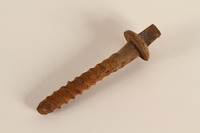
Railroad spike from Treblinka concentration camp
Object
Rail screw spike used for the railways at Treblinka concentration and extermination camp in Poland. Rail screws secure timber railway ties for railroad tracks. Treblinka was located about fifty miles north of Warsaw on the main Warsaw-Bialystok railroad line. A forced labor camp was established there in November 1941 by the SS and the German police authorities of the Generalgouvernement in German controlled Poland. In July 1942, Treblinka II, a killing center, was built near the village of Wolka Okraglik along the Malkinia-Siedlce railway line. The Germans built a rail spur to connect the two camps. Nearly 1 million Jews were killed at Treblinka II before it was closed in the fall of 1943. As Soviet troops moved into the area in late July 1944, camp authorities shot the remaining prisoners and evacuated the camp.
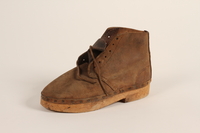
Pair of handmade wooden soled suede boots from Mauthausen concentration camp
Object
Pair of handmade leather ankle boots with wooden soles made at Mauthausen concentration camp. Soon after Nazi Germany incorporated Austria in March 1938, SS Chief Himmler chose a site for a camp to incarcerate Austrian traitors near the town of Mauthausen. The first prisoners were sent there in August. Until the war's end on May 7, 1945, Mauthausen inmates chiefly consisted of convicted criminals, "asocials," such as Roma and Sinti, political opponents, including anti-Franco Spanish Republicans, and religious conscientious objectors, such as Jehovah's Witnesses. The camp had a killing center and a staff of German doctors who conducted pseudoscientific medical experiments. It eventually had fifty subcamps and a large forced labor force to work the nearby granite quarry. Approximately 95,000 prisoners died or were killed at the camp. The gas chamber was in use until late April 1945. The SS guards abandoned the camp on May 3 and it was liberated by US troops on May 5.
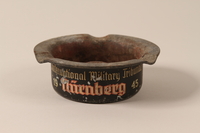
Commemorative ashtray used during the International Military Tribunal in Nuremberg
Object
Souvenir ashtray printed with International Military Tribunal available during the war crimes trials held in Nuremberg, Germany, in 1945-46. After the end of the war and the defeat of Nazi Germany on May 7, 1945, Allied occupation authorities convened an International Military Tribunal to seek justice for crimes against humanity, evidenced by the Holocaust, perpetrated by Nazi Germany. The best known trial of major German officials began in October 1945, when the IMT formally indicted the Nuremberg defendants on four counts: crimes against peace, war crimes, crimes against humanity, and conspiracy to commit these crimes; the verdicts were delivered on October 1, 1946.
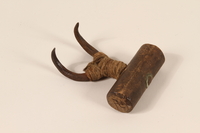
Small two pronged bale hook with swastikas drawn on the wooden handle
Object
Small forked bale hook with hand drawn swastikas that may be been used in Europe during the Holocaust. This short type of hook generally would be used to move bags and bundles in warehouses.
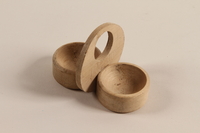
Handcrafted wooden double dished set etched Dachau KZ
Object
Handcrafted wooden set with two shallow bowls attached to a circular handle etched Dachau KZ to commemorate Dachau concentration camp. Dachau was the first concentration camp established by the Nazi government in 1933, originally for political prisoners. Over time, other groups were interned at Dachau, such as Jehovah's Witnesses, Roma, homosexuals, repeat criminal offenders, and Jews. The SS used it as the training center for SS concentration camp guards. It was divided into two parts: the concentration camp and the crematorium for the disposal of the bodies of inmates who died at the camp. The camp was liberated by United States forces on April 29, 1945.
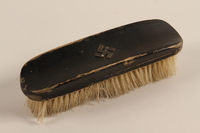
Hairbrush with a metal swastika
Object
Floreloid brand natural bristle hairbrush with a small metal swastika nailed to the wooden handle. This style was marketed as a military hair brush with a sterling silver decorative crest mounted on the handle. The product was popular in the United States at the beginning of the 20th century. This brush may have belonged to Ernst Kaltenbrunner, Chief of the Security Police known as the Gestapo in Nazi Germany. He was the most senior member of the SS captured alive after the defeat of Germany in May 1945. He was directly involved with the implementation of the Final Solution and operation of the concentration camp system. Kaltenbrunner was found guilty of war crimes by the International Military Tribunal at Nuremberg, sentenced to death, and hanged October 16, 1946. The brush was given to the West German ambassador to the United States, Heinz L. Krekeler, at some point after the war by Major Robert Matteson, the US counterintelligence officer who captured Kaltenbrunner on May 12, 1945.
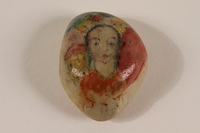
Small rock with a painted portrait of a dark haired woman killed in a concentration camp
Object
Small oval rock with a painted portrait of a woman in an orange dress created by Miss Relis, possibly a Holocaust survivor, to remember friends who had been killed in the concentration camps established by Germany during the Holocaust.
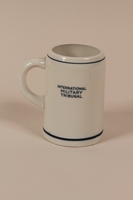
International Military Tribunal Stork Club white porcelain mug
Object
White porcelain stein marked International Military Tribunal presumably available during the war crimes trials held in Nuremberg, Germany, in 1945-46. The Stork Club was the club for enlisted military personnel serving at the trials. After the end of the war and the defeat of Nazi Germany on May 7, 1945, Allied occupation authorities convened an International Military Tribunal to seek justice for crimes against humanity, evidenced by the Holocaust, perpetrated by Nazi Germany. The best known trial of major German officials began in October 1945, when the IMT formally indicted the Nuremberg defendants on four counts: crimes against peace, war crimes, crimes against humanity, and conspiracy to commit these crimes; the verdicts were delivered on October 1, 1946.
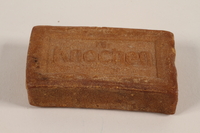
Light brown bar of curd soap produced Nazi Germany
Object
Light brown soap bar produced by the Chr. Durr Company of Bamberg, Germany, during the Nazi era, 1933-1945.
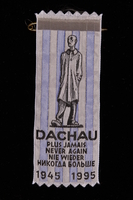
Commemorative ribbon for the 50th anniversary of Dachau concentration camp
Object
Blue and white striped embroidered ribbon, reminiscent of a concentration camp uniform issued in 1995 to commemorate the 50th anniversary of the liberation of Dachau concentration camp by American troops on April 29, 1945. Dachau was the first concentration camp established by the Nazi government in 1933, originally for political prisoners. Over time, other groups were interned at Dachau, such as Jehovah's Witnesses, Roma, homosexuals, repeat criminal offenders, and Jews. The SS used it as the training center for SS concentration camp guards and it had an active medical experiment program. Most of the prisoners were used as forced labor. Nearly 200,000 people were incarcerated at Dachau and nearly 20,000 inmates died there, although the exact number is not known.s
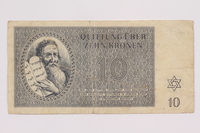
Theresienstadt ghetto-labor camp scrip, 10 kronen note
Object
Scrip, valued at 10 kronen, issued in Theresienstadt (Terezin) ghetto-labor camp in 1943. All currency was confiscated from deportees upon entry and replaced with scrip and ration coupons that could be exchanged only in the camp. The currency was designed by inmate Peter Kien and printed by the National Bank of Prague. Inmates received the scrip according to a 5-tiered distribution system or payment schedule for conscript labor arranged by the Jewish Council of Elders who administered the daily life of the ghetto for the Germans. It is unclear what, if anything, could be purchased with the scrip, which was printed in great volume. The Germans had the scrip issued to instill a sense of normalcy within the huge ghetto. Theresienstadt camp, located in German occupied Czechoslovakia, existed for 3.5 years, from November 24, 1941 to May 9, 1945. Approximately 140,000 Jews were sent to Theresienstadt; nearly 90,000 were deported to near certain death in the east, and roughly 33,000 died in the camp, most of disease and starvation.
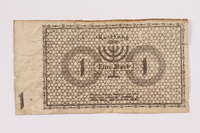
Łódź (Litzmannstadt) ghetto scrip, 1 mark note
Object
1 [eine] mark receipt issued in the Łódź ghetto in Poland beginning in May 1940 until the ghetto was liquidated in summer 1944. Nazi Germany invaded Poland on September 1, 1939, and occupied Łódź one week later. Łódź was renamed Litzmannstadt and, by February 1940, the Germans forcibly relocated the large Jewish population of 160,000 into a small, sealed ghetto. All residents had to work and many were forced laborers in ghetto factories. Residents were forbidden to have German currency, and the Jewish Council was ordered to create a system of Quittungen [receipts] that could be used only in the ghetto. The scrip, sometimes referred to as rumkis, after the Elder of the Judenrat, Mordechai Rumkowski, was issued in 7 denominations: 50 pfenning, 1, 2, 5, 10, 20, 50, and 100 marks, as well as coins. It acted as a labor incentive and facilitated the confiscation of money and goods from internees. There was little to exchange it for in the ghetto. Living conditions were horrendous; the severe overcrowding and lack of food made disease and starvation common. In January 1942, mass deportations to Chelmno killing center began; half the residents were murdered by the end of the year. In summer 1944, Łódź, the last ghetto in Poland, was destroyed and the remaining Jews were sent to Chelmno and Auschwitz-Birkenau killing centers.
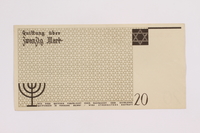
Łódź (Litzmannstadt) ghetto scrip, 20 mark note
Object
20 [zwanzig] mark receipt issued in the Łódź ghetto in Poland beginning in May 1940 until the ghetto was liquidated in summer 1944. Nazi Germany invaded Poland on September 1, 1939, and occupied Łódź one week later. Łódź was renamed Litzmannstadt and, by February 1940, the Germans forcibly relocated the large Jewish population of 160,000 into a small, sealed ghetto. All residents had to work and many were forced laborers in ghetto factories. Residents were forbidden to have German currency, and the Jewish Council was ordered to create a system of Quittungen [receipts] that could be used only in the ghetto. The scrip, sometimes referred to as rumkis, after the Elder of the Judenrat, Mordechai Rumkowski, was issued in 7 denominations: 50 pfenning, 1, 2, 5, 10, 20, 50, and 100 marks, as well as coins. It acted as a labor incentive and facilitated the confiscation of money and goods from internees. There was little to exchange it for in the ghetto. Living conditions were horrendous; the severe overcrowding and lack of food made disease and starvation common. In January 1942, mass deportations to Chelmno killing center began; half the residents were murdered by the end of the year. In summer 1944, Łódź, the last ghetto in Poland, was destroyed and the remaining Jews were sent to Chelmno and Auschwitz-Birkenau killing centers.
Robert L. White papers
Document
The papers contain documents and copy prints of photographs relating to the Holocaust. These items were acquired by Robert L. White over an extended period of time.
Efka Pyramiden cigarette papers in a green packaging sleeve made in Nazi Germany
Object
Unused package of fifty Efka cigarette rolling papers manufactured in Nazi Germany. These packets may have been supplied for observers during the war crimes trials held in Nuremberg, Germany, in 1945-46. This brand was very popular in the 1930-1940s and was distributed to German troops. The package has a green graphic design featuring camels and pyramids. Around March 1943, the British psychological warfare unit used Efka Pyramiden packets to distribute propaganda that encouraged German soldiers to malinger, feign illness, or avoid reporting for duty. They reproduced the package sleeve and, in place of cigarette papers, inserted ten thin papers with suggestions for how to avoid work. The small packet could be distributed without notice by placing them in coat pockets or leaving in cafes and could be air dropped.
Efka Pyramiden cigarette papers in a colorful packet with camels and pyramids made in Nazi Germany
Object
Unused package of fifty Efka cigarette rolling papers manufactured in Nazi Germany. This brand was very popular in the 1930-1940s and was distributed to German troops. The package has a graphic design featuring red camels in front of a red sphinx and and pyramids against white sand and a yellow sky. Around March 1943, the British psychological warfare unit used Efka Pyramiden packets to distribute propaganda that encouraged German soldiers to malinger, feign illness, or avoid reporting for duty. They reproduced the package sleeve and, in place of cigarette papers, inserted ten thin papers with suggestions for how to avoid work. The small packet could be distributed without notice by placing them in coat pockets or leaving in cafes and could be air dropped.



